Software overview¶
Welcome tour¶
After the software has been started, a “Welcome Tour” will automatically begin to guide you through the basic functionalities of OXYGEN. For this purpose, a window appears at the beginning (see ① in Fig. 10).
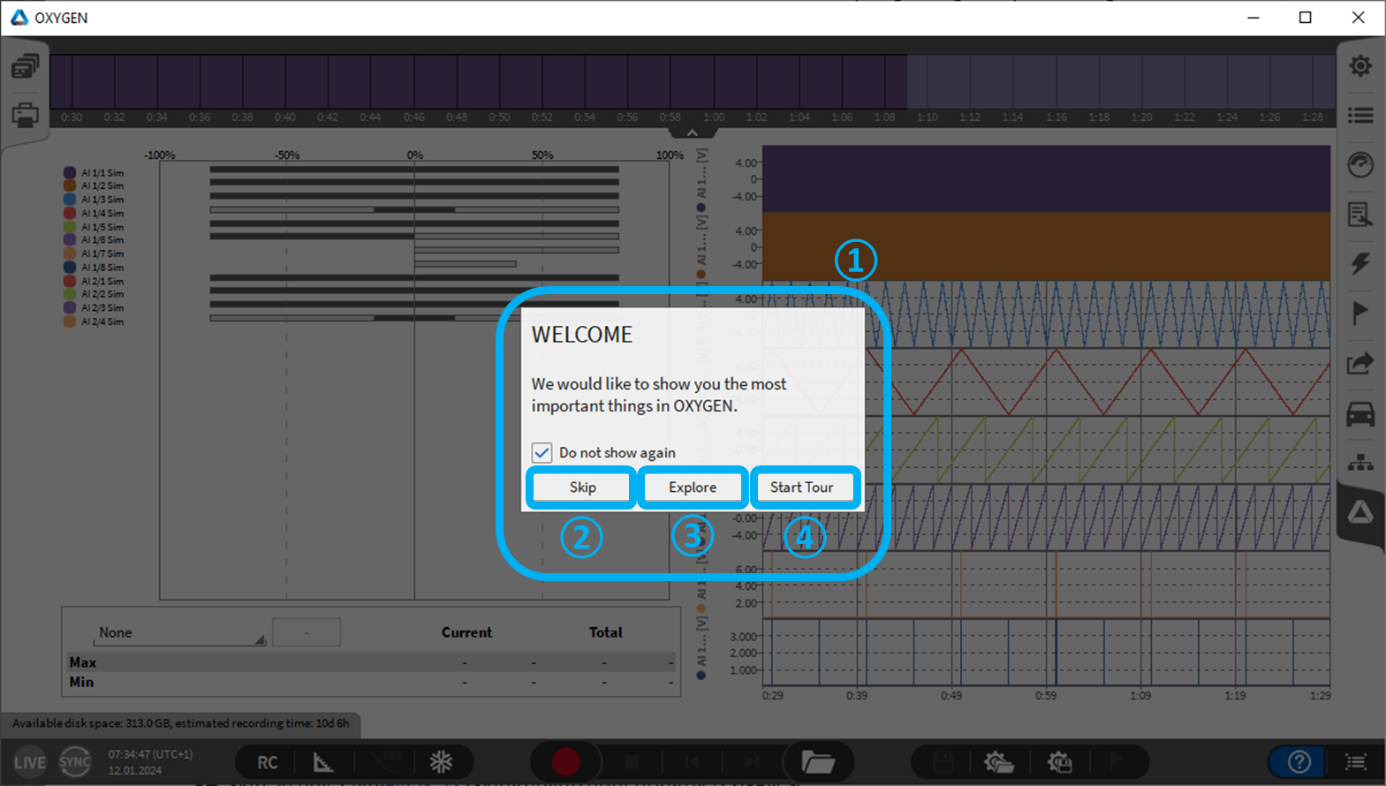
Fig. 10 Welcome¶
You have the following options for the introduction to OXYGEN:
“Skip” (see ② in Fig. 10): Skip the introduction to OXYGEN.
“Explore” (see ③ in Fig. 10): The introduction is started. Now all available icons and buttons on the measurement screen are outlined in red. If you navigate with the mouse cursor over a bordered area, a short descriptive text about the function is displayed. Click on “x” (see ② in Fig. 11) to quit the introduction.

Fig. 11 Welcome tour description¶
“Start tour” (see ④ in Fig. 10): Let yourself be guided through the various basic functions of OXYGEN. By clicking on “<<” or “>>” (see ① in Fig. 12) it is possible to jump through the individual icons, buttons and displays, the descriptions are automatically displayed for the respective area. By clicking on “x” (see ① in Fig. 12) you can quit the introduction.

Fig. 12 Welcome tour start¶
Measurement screen¶
After starting the software, the following screen will appear. OXYGEN will instantly start to acquire data but will not store it yet.
To activate the default measurement screen when OXYGEN will be started, the corresponding startup setting must be checked (see Fig. 13). This setting is activated per default, when starting OXYGEN the first time.
The saturation meter (Saturation meter) as well as a chart recorder instrument (see Recorder), displaying the first 8 analogue input channels, is part of the OXYGEN default measurement screen (see Fig. 14).
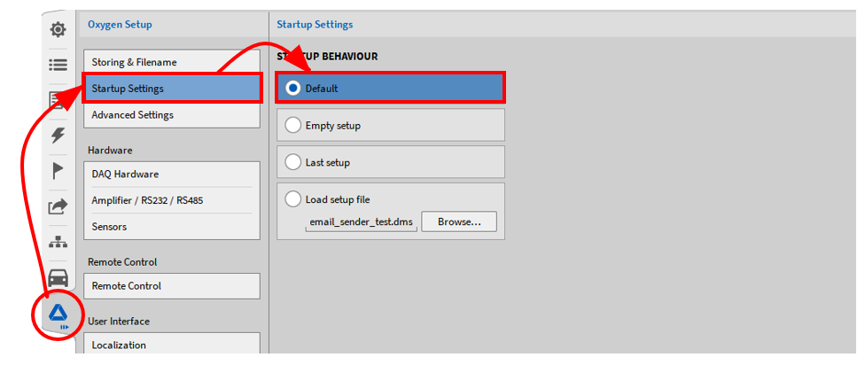
Fig. 13 Settings to activate automatic visualization of default measurement screen¶
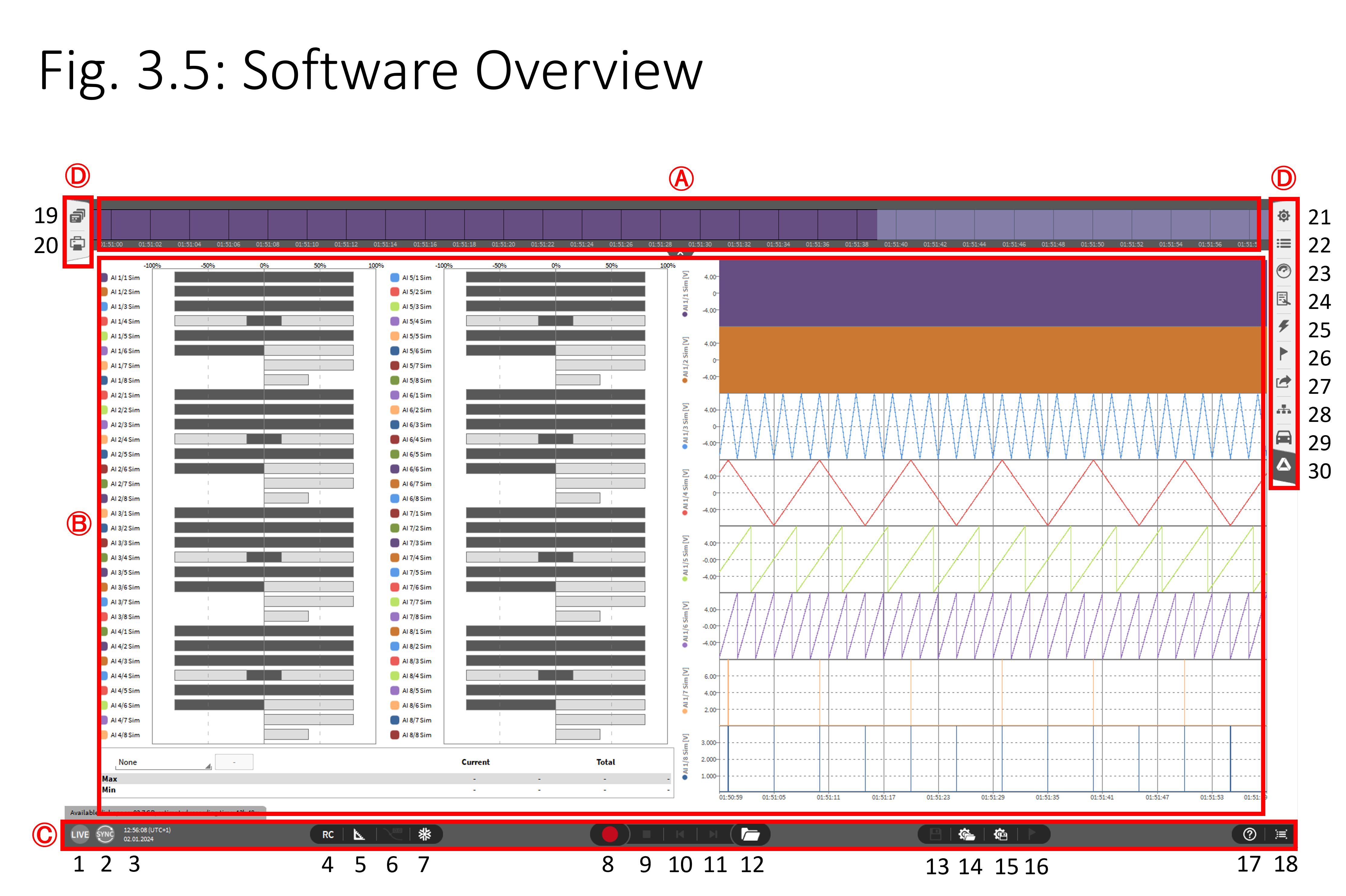
Fig. 14 Software overview¶
No. |
Name |
No. |
Name |
|---|---|---|---|
A - Overview bar |
C - Menu functions |
||
- |
15 |
||
B - Measurement display |
16 |
||
- |
17 |
Welcome tour button |
|
C - Menu functions |
18 |
||
1 |
D - Action bar |
||
2 |
19 |
||
3 |
20 |
||
4 |
21 |
||
5 |
22 |
||
6 |
23 |
||
7 |
24 |
||
8 |
25 |
||
9 |
26 |
||
10 |
27 |
||
11 |
28 |
||
12 |
29 |
Bird’s eye |
|
13 |
30 |
||
14 |
|||
Overview bar¶

Fig. 15 Overview bar¶
The Overview bar gives a rough overview about the measurement data. It displays the time dependent trend of one selected data channel. During the data review and analysis, the orange box shows the position of the currently displayed data in the measurement file (see Fig. 28). The user can change the displayed channel. Therefor he must open the Data Channels Menu and move the desired channel via drag and drop to the Overview bar (see Fig. 15).

Fig. 16 Change displayed channel in the Overview bar¶
Shows the time dependent trend of one selected input channel.
Measurement display area¶
Default measurement screen header with several instruments that display the acquired data.
For adding or changing instruments on a screen, refer to Adding an instrument to the measurement screen and channel assignment.
For managing several screens, refer to Screens menu.
Action bar¶
Contains relevant push buttons.
Record button¶
Starts or pauses REC mode.
Stop button¶
Terminates an active recording or returns to then LIVE mode when the PLAY mode is active.
Reverse button¶
Only active in PLAY mode; A click on this button will move the cursor 5 seconds back.
Fast forward button¶
Only active in PLAY mode; A click on this button will move the cursor 5 seconds forward.
Open data file button¶
Opens a UI to select a data file and switches in the PLAY mode.
Store data button¶
Stores changes to a data file that were made during analysis in the PLAY mode, whereas the file will be overwritten. To save the measurement file under a new name with the changes made, open the small Measurement Settings menu and click on Save DMD as… .
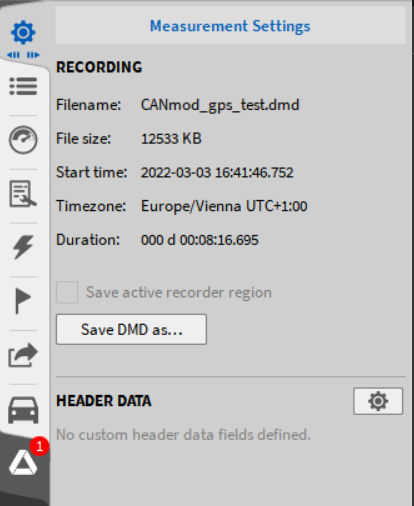
Fig. 17 Save DMD as…¶
Open Setup file button¶
Opens a UI to select a setup file, for more information refer to Loading a Measurement Setup File.
Save setup file button¶
Saves software settings to a setup file, for more information refer to Saving a Measurement Setup file.
Add Marker button¶
Adds a marker on the actual point of time; Enabled in REC and PLAY mode.
Lock Screen button¶
Locks the measurement screen.
Design mode button¶
Activates the Design mode to manipulate the surface of the measurement screens and add, delete or change the Instruments on the screen. For detailed information refer to Adding an instrument to the measurement screen and channel assignment. With the middle mouse button, the Design Mode can be toggled.
Data Labels button¶
Activates measurement labels; for detailed information refer to Mouse-over information.
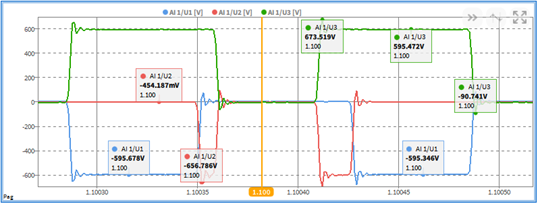
Fig. 18 Activate labels¶
Freeze button¶
Freezes the actual screen.
Mode indicator¶
Shows the current software indicator mode. OXYGEN has three different Operating Modes: LIVE, REC and PLAY. The actual software mode is displayed in the Action bar (see ① in Fig. 14). The properties of the different modes are explained in the following section:
LIVE mode: OXYGEN is only acquiring and displaying data but not storing it to a data file yet. This mode is active when OXYGEN is started, a measurement is stopped or when a data file is closed.
REC mode: OXYGEN is acquiring data and storing it to a data file. A red line above the Action bar indicates this mode. OXYGEN stores the data automatically to a data file. An explicit command for storing the acquired data to a file is not necessary. For changing the data storing settings, refer to General settings.
PLAY mode: Mode for reviewing, analyzing and exporting data. This mode is activated after a data file was loaded. A green line above the Action bar indicates this mode.
Sync mode indicator¶
Shows the current Sync status of the software.
Time¶
Shows the actual time, time zone and date; can be displayed on the measurement screen via drag’n’drop, for more details see Text instrument.
Toggle button¶
Quick access to Data channels menu; toggles between the current screen and the data Channel list
Menu functions¶
Measurement settings menu¶
Opens the System Settings menu; for detailed information refer to Measurement settings.
Data Channels menu¶
Opens the Data Channels menu; for detailed information refer to Data channels menu.
Instruments menu¶
Opens the Instruments menu for detailed information refer to Instruments and instrument properties.
Instrument properties menu¶
Opens the properties of a||| selected Instrument; for detailed information refer to Instruments and instrument properties. The Instrument Properties can also be opened with a double click on the desired instrument.
Triggered Events menu¶
Opens the Triggered Events menu; for detailed information refer to Triggered Events.
Event List menu¶
Opens the Event List menu; for detailed information refer to Event List.
Export Settings menu¶
Opens the Export Settings menu; for detailed information refer to Export Settings.
OXYGEN-NET menu¶
Opens the OXYGEN-NET menu; for detailed information refer to OXYGEN-NET.
OXYGEN setup¶
Opens the System Information that contains information about the software license and version.
Screens menu¶
Opens the Screens menu; for detailed information refer to Screens menu.
Reporting menu¶
Opens the Reporting menu; for detailed information refer to Reporting tool.
Working with OXYGEN software¶
Online vs. Offline Data Processing¶
This chapter explains the difference between online and offline data processing. As explained in Action bar, there are three different operating modes: LIVE, REC and PLAY mode.
All the data processing, which is done and configured in the LIVE mode is called online data processing. OXYGEN is acquiring data, formula channels etc. can be created and will be saved in the setup, but no data has yet been recorded. These channels cannot be deleted in the post-processing.
All the data processing, which is done after a recording in the post-processing is called offline data processing. When reviewing a measurement file OXYGEN is opened in PLAY mode. That is the mode for reviewing, analyzing, and exporting data. These channels can be deleted until the file is closed the first until upon creating the channels. The channels will not be saved in the setup, unless a new setup file is created from the measurement file (see ⑤ in Fig. 27).
The difference for an online and offline created channel, can also be seen in the different colored Stored indicator in the channel list. This indicator is red for online created channels and green for offline created channels. As seen in Fig. 19, both statistics channels were created before the recording was started, therefore in the LIVE mode of OXYGEN. The two formula channels were created after the recording, when the file was opened again in OXYGEN.
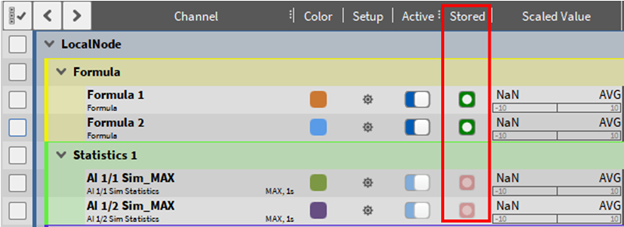
Fig. 19 Different colored stored indicator for online and offline created channels¶
Saving a Measurement Setup file¶
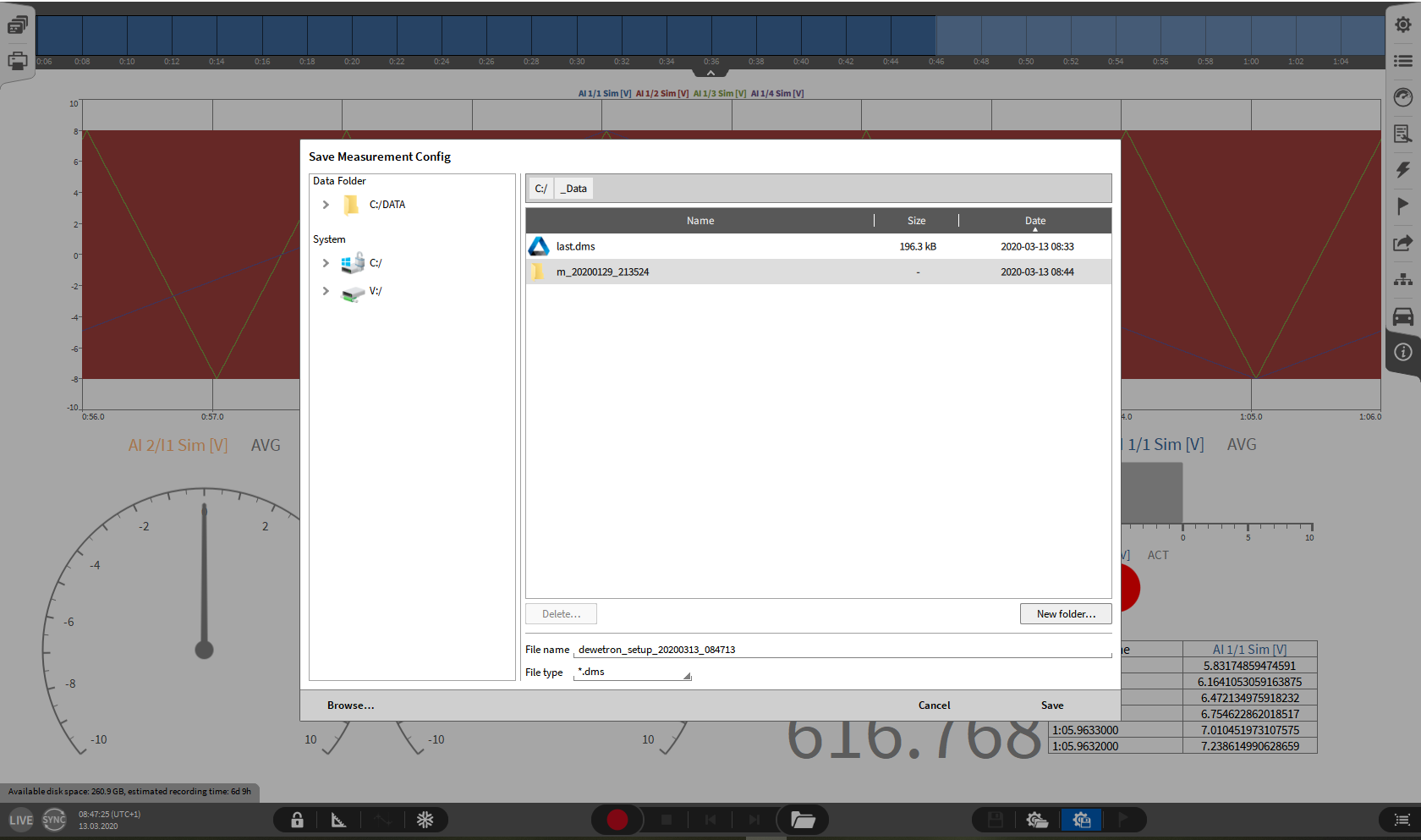
Fig. 20 : Different colored stored indicator for online and offline created channels¶
In order to save a measurement setup file proceed as follows:
Touch or left click the gear and diskette icon in the Action Bar (see Fig. 20 or ⑮ in Fig. 14)
Upon selecting this icon, the Save Measurement Config dialog will appear
Within this dialog select the Data folder, create a New folder or click on the Browse button to open the Windows Explorer dialog and select a location
Define a file Name and by clicking on the Save button the current software settings will be stored to a setup file
Loading a Measurement Setup File¶
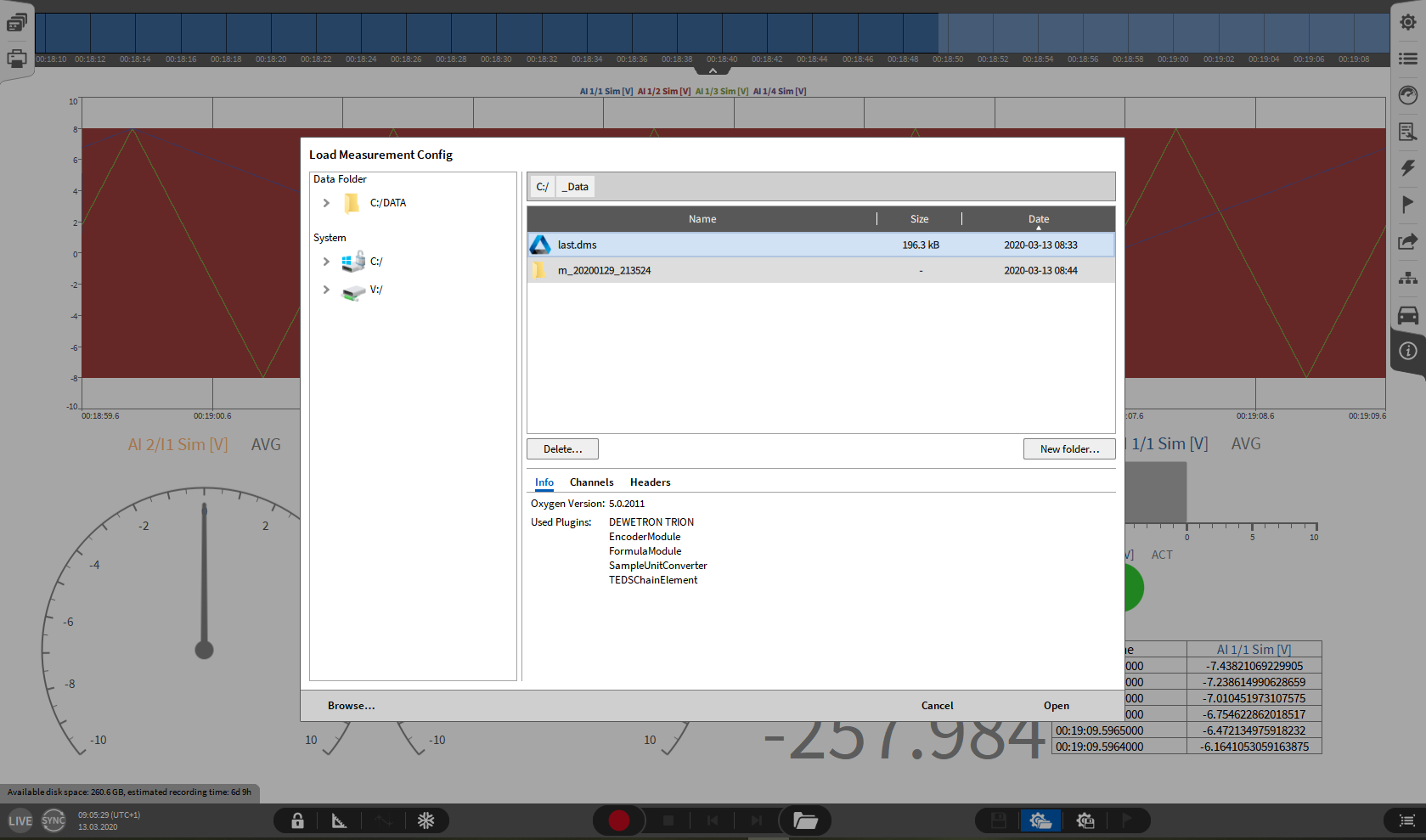
Fig. 21 Loading a Setup file¶
Touch or left click the gear and folder icon along the bottom tool bar (see Fig. 21 ⑭ in Fig. 14)
Upon selecting this icon, a Load Measurement Config dialog will appear
Within this dialog, the user can select the Measurement Setup he would like to open. Info, Channels and Headers contain additional information about the file to ease the search for the correct file.
By clicking on the Browse button, the Windows Explorer dialog will open to more easily browse another folder location
The Open button will open the selected Setup file
If the measurement hardware does not match with the hardware stored in the setup file, the Hardware Match dialog will open (see Fig. 22). Within this dialog, the user can rematch his connected hardware to the hardware stored in the setup file before opening it. Identical TRION modules will be matched automatically or use the Auto button (see Fig. 22). Clicking on Clear will delete the complete match that is done so far. After connecting all necessary channels, the user can click on Apply and the setup loading will be continued.
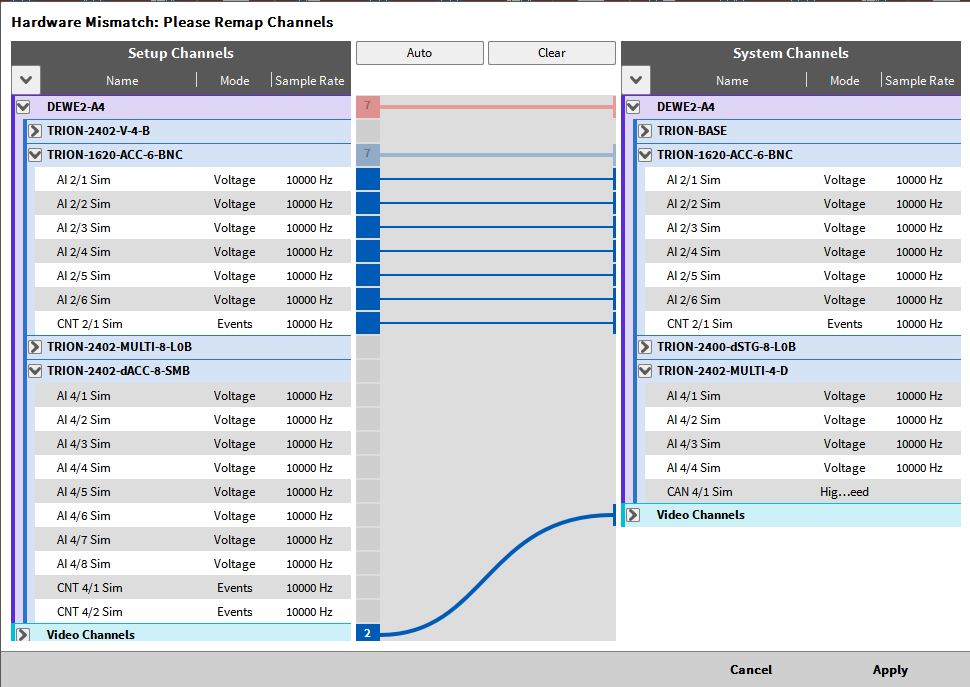
Fig. 22 Hardware Mismatch dialog¶
The hardware Mismatch dialog can also be forced to show up, even if the actual hardware matches the hardware in the setup. This is possible by selecting the Show channel mapping dialog, when opening an OXYGEN Setup (see Fig. 23)

Fig. 23 Forced Hardware Mismatch dialog¶
Reviewing a Data File (PLAY mode)¶
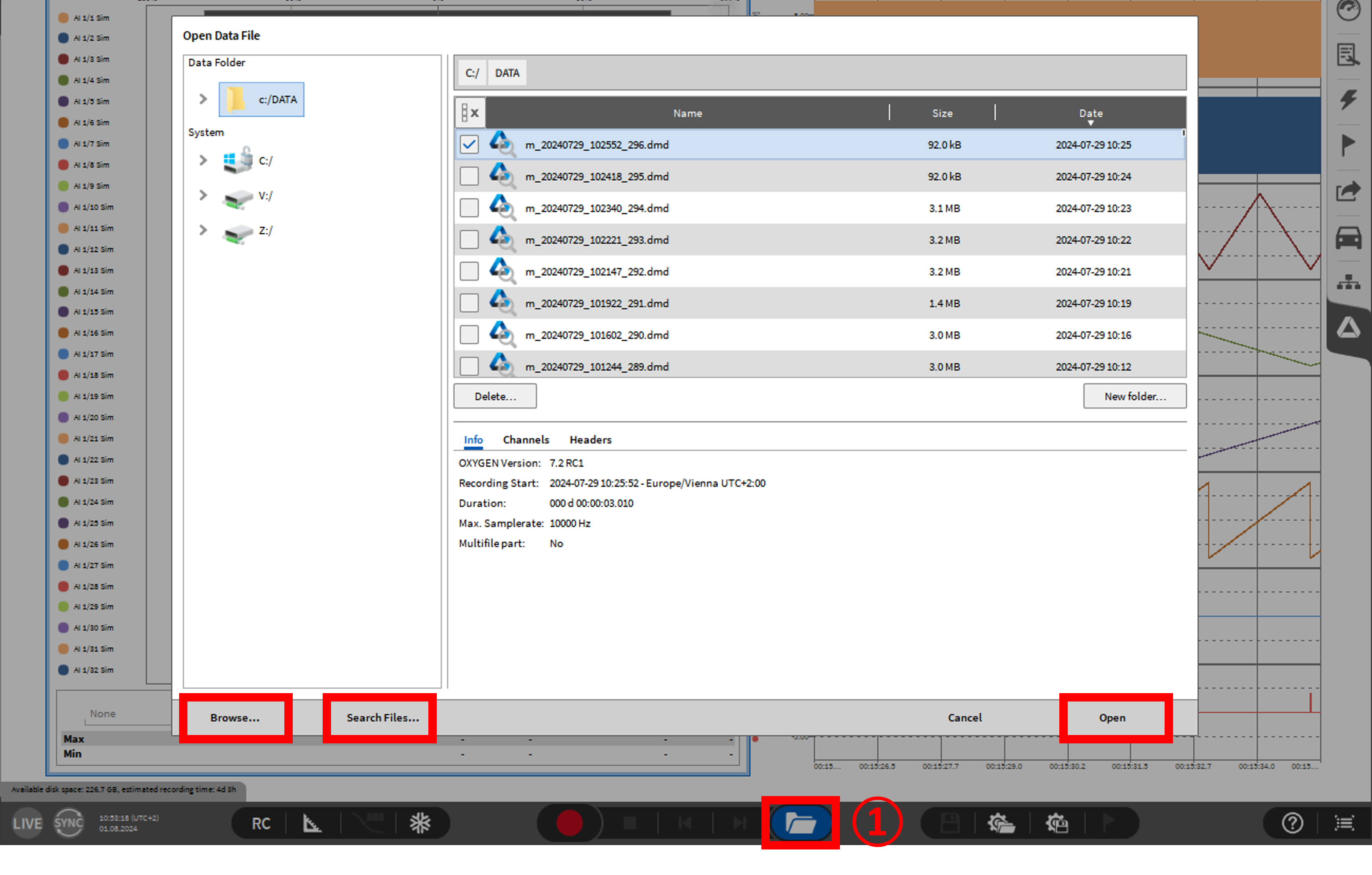
Fig. 24 Opening a Data File¶
Touch or left click the folder icon in the Action bar (see ① Fig. 24 or ⑫ in Fig. 14)
Upon selecting this icon, an Open Data File dialog will appear.
Select the appropriate Data Folder on the left side of the menu.
Once the Data Folder is found, the Data file list will be populated with *.dmd Data files showing their name, size, and date of recording.
Within this dialog, the user can select the Data file he would like to open. Info, Channels and Headers contain additional information about the file to ease the search for the correct file.
By clicking on the “Browse…” button the Windows Explorer dialog will open to browse the right Data Folder.
The “Search Files…” button will open a dialog window enabling to filter the data files by AND, OR conditions. The conditions cannot be used sequentially. To switch from AND to OR, simply click on the AND (see Fig. 25).

Fig. 25 Search files filter options¶
The “Configure…” button enables to specify additional folders via to scan and whether subfolders are scanned for data files (see Fig. 26).

Fig. 26 Configure folder and optional subfolder to scan¶
The Open button will open the selected Setup file (see Fig. 24).
Along the top of the newly opened data file lies the Overview Bar (see Fig. 27 or Ⓐ in Fig. 14). The Overview Bar displays the events that have taken place during this measurement. Such as: start, pause, resume, current playback time position, and termination of recording.
Once the user clicks the green PLAY button (see ① Fig. 27) at the bottom of the screen the yellow playback position cursor will stream across the screen and the displays currently on the screen will then become active, displaying the data currently seen at that playback position.
The playback speed can be changed by clicking on the Speed button (see ② Fig. 27 or Fig. 28). Select a speed from the shown buttons or enter an individual value in the field between 1000x to 1/1000x. Note: Audio replay only working with a playback speed of 1x (original speed).
Once finished reviewing the data file, save the file by clicking on the save button in the action bar or save the file with a new name by opening the small measurement settings menu and click on Save DMD as. Select then the Eject button (see ③ in Fig. 27) which is located to the right of the Speed button. If you do not want to save the data file, only click on the Eject button and select Discard in the pop-up window. After that OXYGEN will be in LIVE mode again and start to acquire data.

Fig. 27 Loaded Data File – Overview¶

Fig. 28 Changing the playback speed of a data file¶
Note
The Design mode can be activated to add, move or delete Instruments in the PLAY mode as well. For detailed information, refer to Adding an instrument to the measurement screen and channel assignment.
A Recorder instrument is very useful during playback, because it also allows you to see all the different events that may have happened during a measurement
The Event List menu (see Fig. 27) will clearly display all events and the points of time the events occurred in a list. For adding a marker to an event, refer to Event List.
Changes that were applied to the data file during the analysis can be saved to the data file by pressing the diskette-button (see ④ in Fig. 27).
A setup file based on the settings of a data file can be created by pressing the gear-diskette-button (see ⑤ in Fig. 27).
Custom ordering of menu locations¶
OXYGEN allows the user to customize his experience within the software. Users can re-order the menu selection panels on the opposing side bar. This allows the user to have multiple menus open at the same time. To change the order, the user can select the respective menu and must keep the mouse button pressed for one second. Then a blue background on the menu sign will appear. Now the user can move the menu to the desired position while keeping the button pressed. It is also possible to move a menu from the right sidebar to the left sidebar and vice versa.
Note
The user may find it difficult to place the menus back in the default order once a change has been made. To reset the position of your menus, head into System Settings > UI Options and select the Reset button found under the Sidebar position section (see ① in Fig. 29).
The user can also swap the right and the left sidebar. To do so, head again into System Settings > UI Options and select Left side under the Sidebar position (see ② in Fig. 29).
The user can also change the width of the menu sidebar.
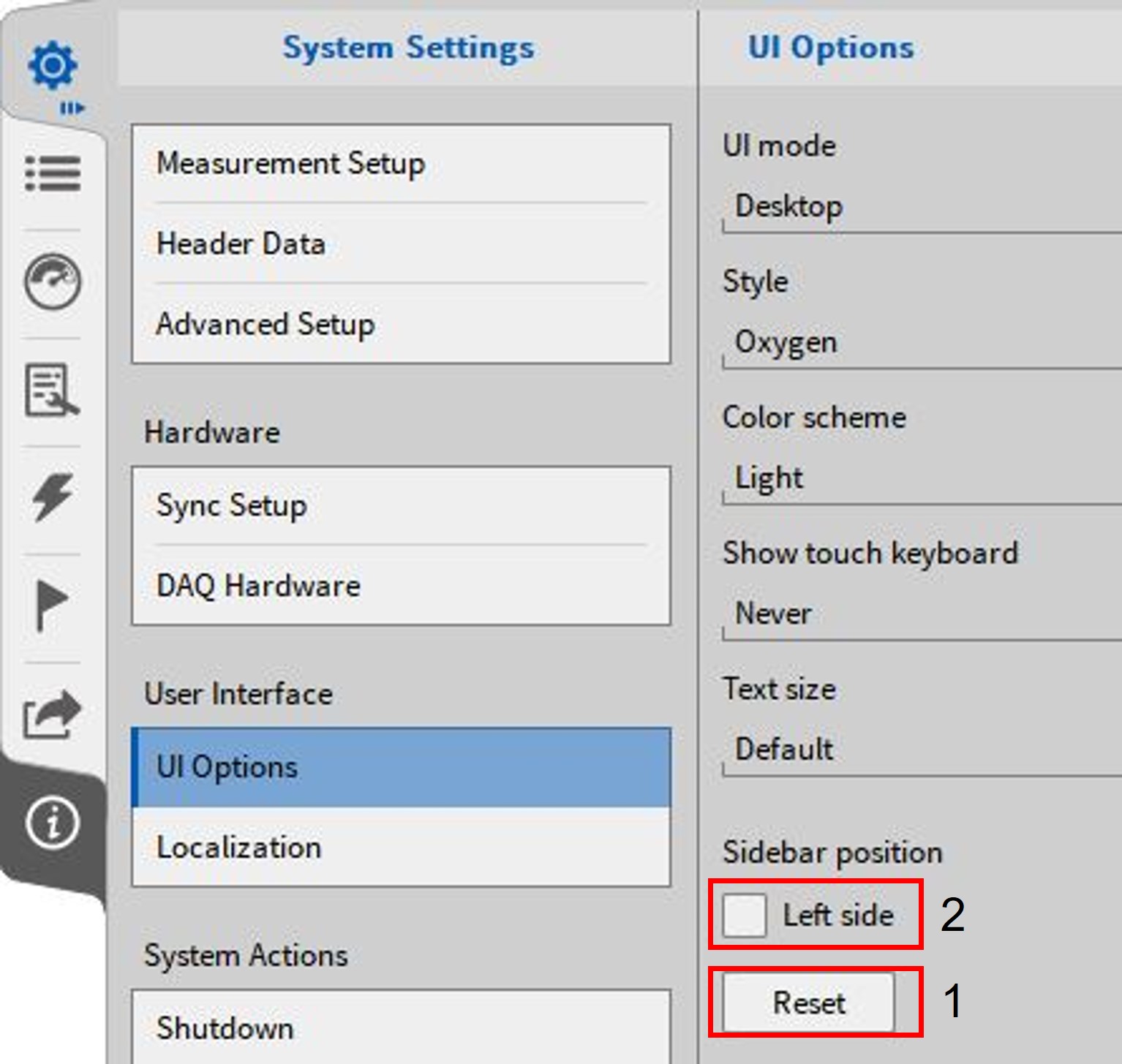
Fig. 29 Sidebar position reset¶
OXYGEN shortcuts¶
The following shortcuts can be helpful when using OXYGEN.
Shortcuts |
Effect |
|---|---|
Ctrl + Q |
Close OXYGEN |
Ctrl + O |
Open recordings (data files) |
Ctrl + A |
Select all (Screens, Instruments) |
Ctrl + S |
Save measurement setup (*.dms) in LIVE Mode or store the currently opened datafile (*.dmd) in PLAY Mode |
Ctrl + F |
Toggle between channel list and last used screen |
Ctrl + C |
Copy instrument, channel settings… |
Ctrl + V |
Paste from clipboard |
F11 |
Enable fullscreeen mode |
OXYGEN viewer¶
It is possible to open OXYGEN multiple times to review and analyze data in the Viewer Mode. Datafiles can be opened directly from a folder, whenever OXYGEN is already running. This Viewer Mode is displayed on the splash screen with the addition “Viewer” when OXYGEN is starting, shown in Fig. 30.
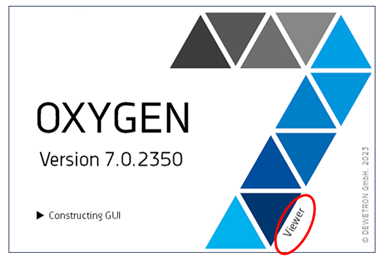
Fig. 30 Splash Screen for the OXYGEN Viewer¶
The core feature of recording data is only available with the main OXYGEN window, nonetheless, all other features like the post-processing features are also available in the Viewer Mode. Also, during recording this mode can be used to look at an already recorded datafile by opening it in the Viewer Mode.
If a datafile is opened in Viewer Mode and ejected again (see ② in Fig. 27), a notice appears above the Action Bar shown in Fig. 31. Another datafile can be opened to analyze and review.
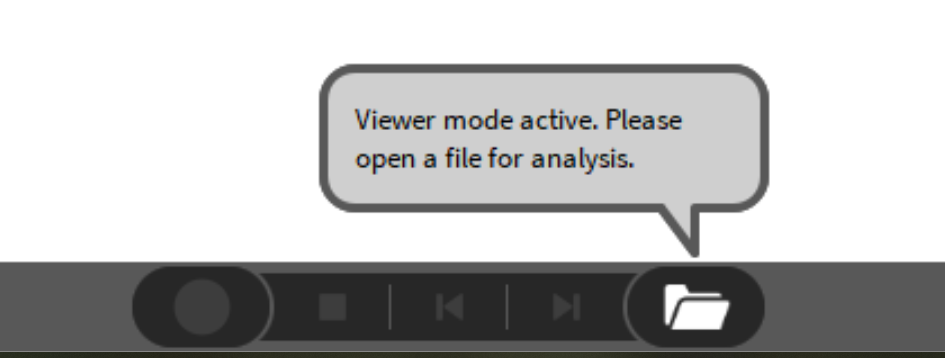
Fig. 31 OXYGEN Viewer notice¶
Note
Multiple OXYGEN Viewer windows can be opened at the same time.